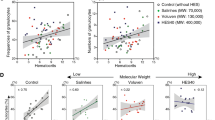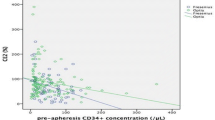Abstract
Granulocyte transfusion (GTX) is a therapeutic option for severe bacterial or fungal infection in patients with sustained neutropenia after chemotherapy or stem cell transplantation. However, high molecular weight hydroxyethyl starch (HES), which has been used for selective sedimentation of red blood cells during apheresis, is not easily available in many countries including Japan. In this study, we evaluated the efficiency of granulocyte collection using medium molecular weight HES (130 kDa) in combination with the Spectra Optia apheresis system. Apheresis was performed for 2 consecutive days from seven donors and the mean total neutrophil yield from the first and second apheresis was 5.27 ± 3.10 × 1010 and 2.91 ± 2.92 × 1010, respectively. Infusion of concentrates from the first apheresis resulted in a significant neutrophil count increase and concentrates from the second apheresis were enough for maintenance of the neutrophil counts in all the recipients. Although the number of cases is limited, our results clearly show that sufficient number of granulocytes can be harvested by using medium molecular weight HES and this strategy is a safe and effective clinical practice in countries where high molecular weight HES is not available.
Similar content being viewed by others
References
Miyao K, Sawa M, Kurata M, Suzuki R, Sakemura R, Sakai T, et al. A multicenter phase 2 study of empirical low-dose liposomal amphotericin B in patients with refractory febrile neutropenia. Int J Hematol. 2017;105:79–86.
Sano H, Kobayashi R, Suzuki D, Kishimoto K, Hori D, Matsushima S, et al. Differential efficacy of empirical antibiotic therapy for febrile neutropenia in adolescent/young adult (AYA) and child patients. Int J Hematol. 2018;108:543–9.
Illerhaus G, Wirth K, Dwenger A, Waller CF, Garbe A, Brass V, et al. Treatment and prophylaxis of severe infections in neutropenic patients by granulocyte transfusions. Ann Hematol. 2002;81:273–81.
Kerr JP, Liakopolou E, Brown J, Cornish JM, Fleming D, Massey E, et al. The use of stimulated granulocyte transfusions to prevent recurrence of past severe infections after allogeneic stem cell transplantation. Br J Haematol. 2003;123:114–8.
Bux J, Cassens U, Dielschneider T, Duchscherer M, Edel E, Eichler H, et al. Tolerance of granulocyte donors towards granulocyte colony-stimulating factor stimulation and of patients towards granulocyte transfusions: results of a multicentre study. Vox Sang. 2003;85:322–5.
Worel N, Kurz M, Peters C, Hocker P. Serial granulocytapheresis under daily administration of rHuG-CSF: effects on peripheral blood counts, collection efficiency, and yield. Transfusion. 2001;41:390–5.
Kadri SS, Remy KE, Strich JR, Gea-Banacloche J, Leitman SF. Role of granulocyte transfusions in invasive fusariosis: systematic review and single-center experience. Transfusion. 2015;55:2076–85.
Ebihara Y, Ishikawa K, Mochizuki S, Tanaka R, Manabe A, Iseki T, et al. Allogeneic stem cell transplantation for patients with acute myeloid leukaemia developing from severe congenital neutropenia. Br J Haematol. 2014;164:459–61.
Peters C. Granulocyte transfusions in neutropenic patients: beneficial effects proven? Vox Sang. 2009;96:275–83.
Price TH, Boeckh M, Harrison RW, McCullough J, Ness PM, Strauss RG, et al. Efficacy of transfusion with granulocytes from G-CSF/dexamethasone-treated donors in neutropenic patients with infection. Blood. 2015;126:2153–61.
Strauss RG. Neutrophil/granulocyte transfusions collected from G-CSF + dexamethasone-stimulated donors. Curr Opin Hematol. 2015;22:565–7.
Strauss RG. Therapeutic granulocyte transfusions in 1993. Blood. 1993;81:1675–8.
Caspar CB, Seger RA, Burger J, Gmur J. Effective stimulation of donors for granulocyte transfusions with recombinant methionyl granulocyte colony-stimulating factor. Blood. 1993;81:2866–71.
Bensinger WI, Price TH, Dale DC, Appelbaum FR, Clift R, Lilleby K, et al. The effects of daily recombinant human granulocyte colony-stimulating factor administration on normal granulocyte donors undergoing leukapheresis. Blood. 1993;81:1883–8.
Liles WC, Huang JE, Llewellyn C, SenGupta D, Price TH, Dale DC. A comparative trial of granulocyte-colony-stimulating factor and dexamethasone, separately and in combination, for the mobilization of neutrophils in the peripheral blood of normal volunteers. Transfusion. 1997;37:182–7.
Stroncek DF, Yau YY, Oblitas J, Leitman SF. Administration of G-CSF plus dexamethasone produces greater granulocyte concentrate yields while causing no more donor toxicity than G–CSF alone. Transfusion. 2001;41:1037–44.
Ikemoto J, Yoshihara S, Fujioka T, Ohtsuka Y, Fujita N, Kokubunji A, et al. Impact of the mobilization regimen and the harvesting technique on the granulocyte yield in healthy donors for granulocyte transfusion therapy. Transfusion. 2012;52:2646–52.
Janes AW, Mishler JM, Lowes B. Serial infusion effects of hydroxyethyl starch on ESR, blood typing and crossmatching and serum amylase levels. Vox Sang. 1977;32:131–4.
Lee JH, Leitman SF, Klein HG. A controlled comparison of the efficacy of hetastarch and pentastarch in granulocyte collections by centrifugal leukapheresis. Blood. 1995;86:4662–6.
Cancelas JA, Padmanabhan A, Le T, Ambruso DR, Rugg N, Worsham DN, et al. Spectra Optia granulocyte apheresis collections result in higher collection efficiency of viable, functional neutrophils in a randomized, crossover, multicenter trial. Transfusion. 2015;55:748–55.
Leitner GC, Kolovratova V, Horvath M, Worel N. Granulocyte collection using a novel apheresis system eases the procedure and provides concentrates of high quality. Transfusion. 2015;55:991–5.
Ohsaka A, Kikuta A, Ohto H, Ohara A, Ishida A, Osada K, et al. Guidelines for safety management of granulocyte transfusion in Japan. Int J Hematol. 2010;91:201–8.
Thorausch K, Schulz M, Bialleck H, Luxembourg B, Seifried E, Bonig H. Granulocyte collections: comparison of two apheresis systems. Transfusion. 2013;53:3262–8.
Dullinger K, Pamler I, Brosig A, Mohrez M, Hahnel V, Offner R, et al. Granulocytapheresis with modified fluid gelatin versus high-molecular-weight hydroxyethyl starch: a matched-pair analysis. Transfusion. 2017;57:397–403.
Heuft HG, Goudeva L, Schwella N, Blasczyk R. Collection of two consecutive neutrophil concentrates for transfusion from donors mobilized with glycosylated granulocyte-CSF plus dexamethasone. Transfusion. 2004;44:750–7.
Brockmann F, Kramer M, Bornhauser M, Ehninger G, Holig K. Efficacy and side effects of granulocyte collection in healthy donors. Transfus Med Hemother. 2013;40:258–64.
Acknowledgements
Advice and comments given by Miya Araki (senior clinical trainer of TERUMO BCT) has been a great help in preparing this manuscript. This research is partly supported by KAKENHI Grants-in-Aid for Scientific Research from the Japan Society for the Promotion of Science (18K08354 to H.H. and 16K07171 to T.M.), Highway Program for Realization of Regenerative Medicine (JP17bm0504008 to H.H.) and the Acceleration of Transformative research for Medical innovation (ACT-MS) from Japan Agency for Medical Research and Development (AMED) (to H.H.).
Author information
Authors and Affiliations
Corresponding author
Ethics declarations
Conflict of interest
H.H. received research funding from Kyowa Hakko Kirin and Novartis Pharma. I.K. received research funding from Novartis Pharma. J.M.R is an employee of Terumo BCT. A.T-K received financial interests from Bristol-Meyers Squibb K.K, Celgene and Novartis Pharma. T.M. received research funding from Bristol-Meyers Squibb K.K. The remaining authors declare no conflicting financial interests.
Additional information
Publisher's Note
Springer Nature remains neutral with regard to jurisdictional claims in published maps and institutional affiliations.
About this article
Cite this article
Nanya, M., Yurugi, K., Kato, I. et al. Successful granulocyte apheresis using medium molecular weight hydroxyethyl starch. Int J Hematol 110, 729–735 (2019). https://doi.org/10.1007/s12185-019-02755-2
Received:
Revised:
Accepted:
Published:
Issue Date:
DOI: https://doi.org/10.1007/s12185-019-02755-2




